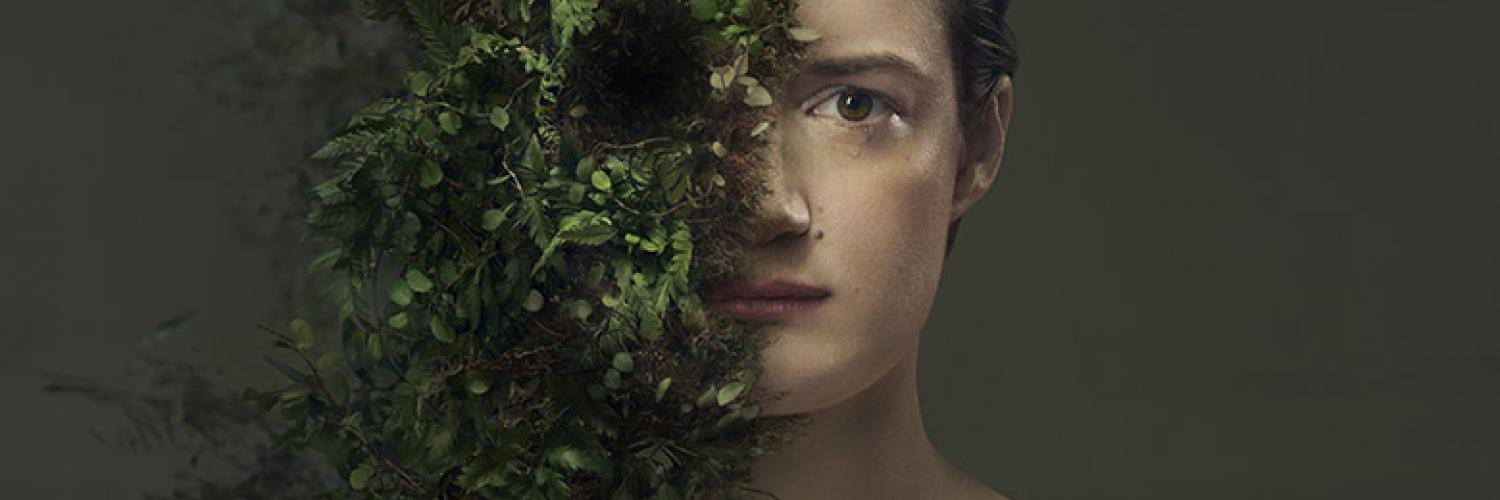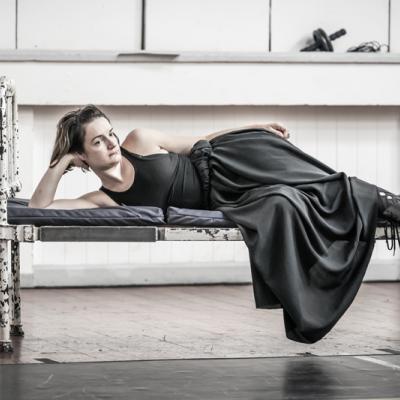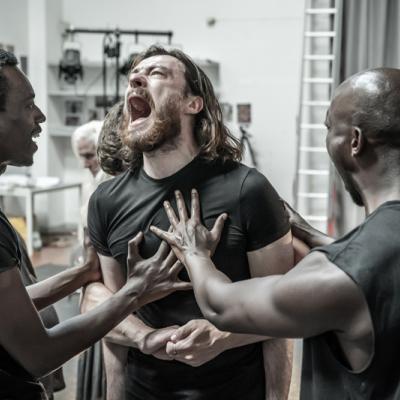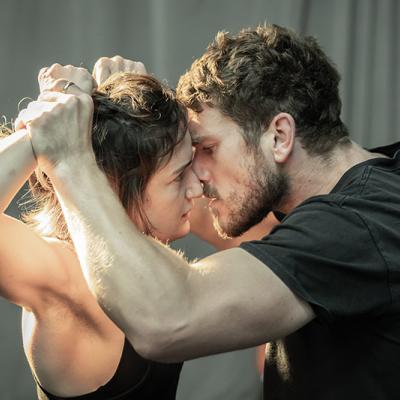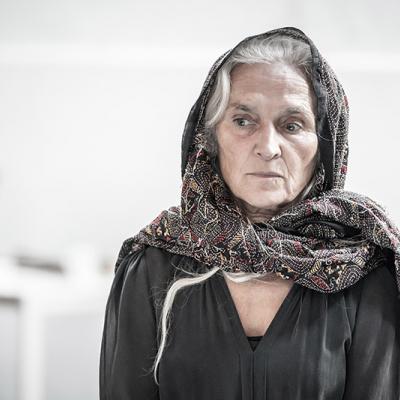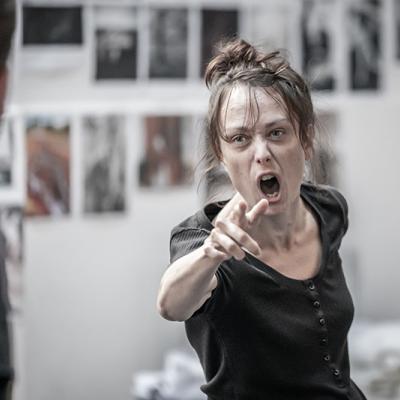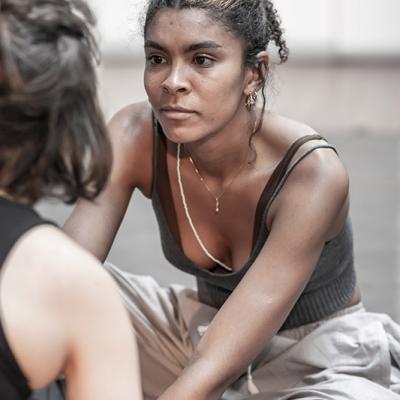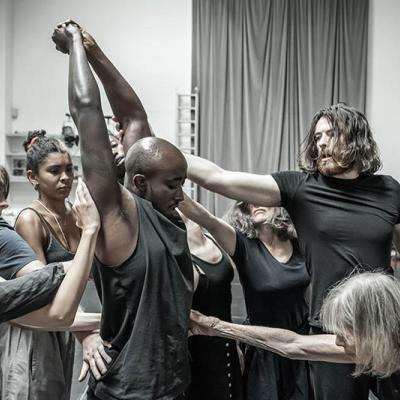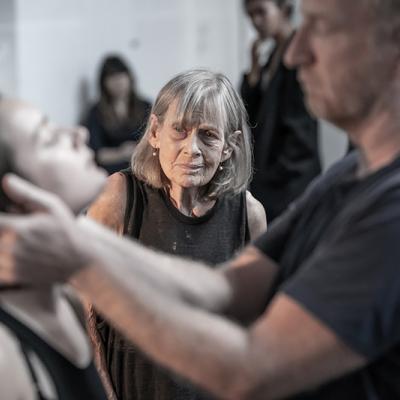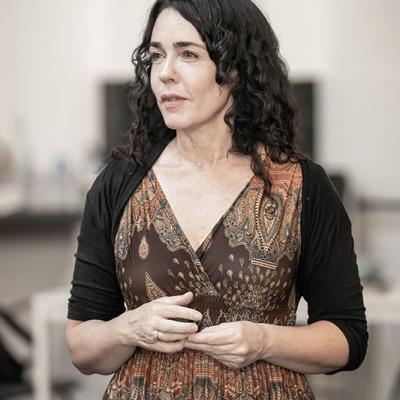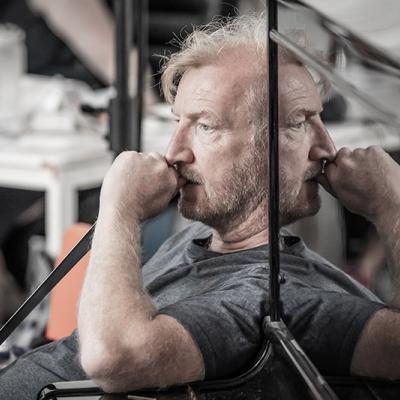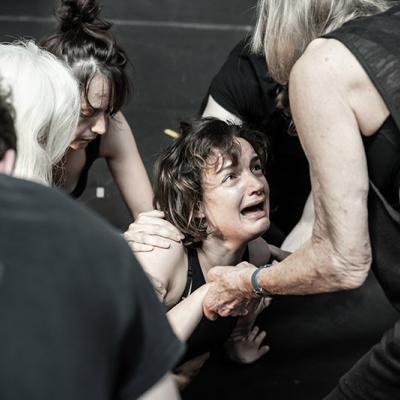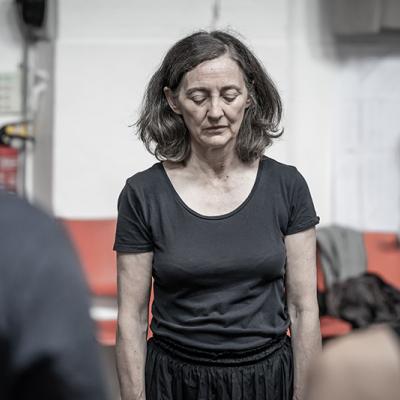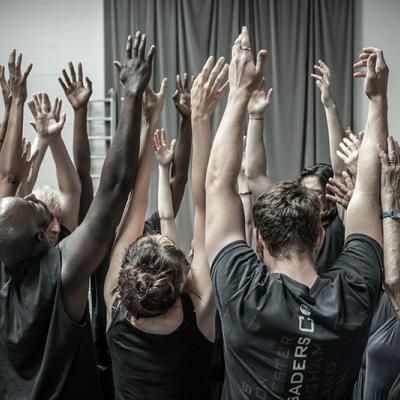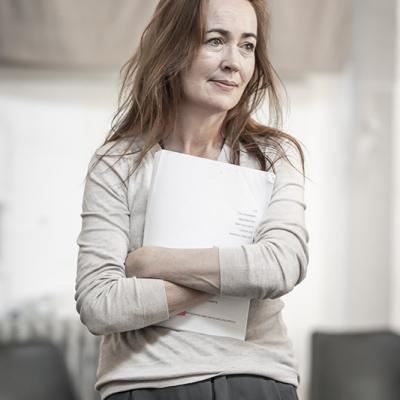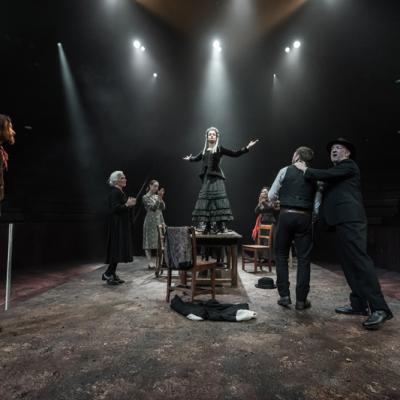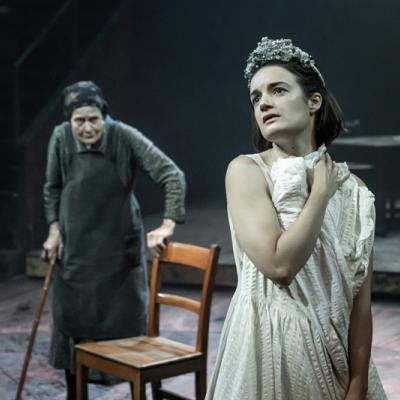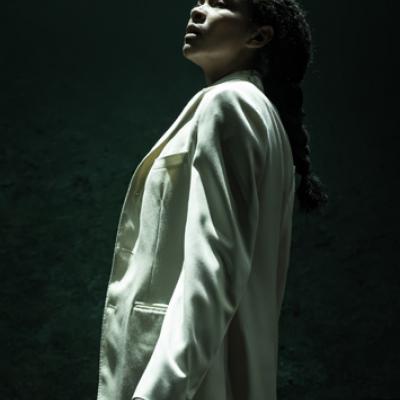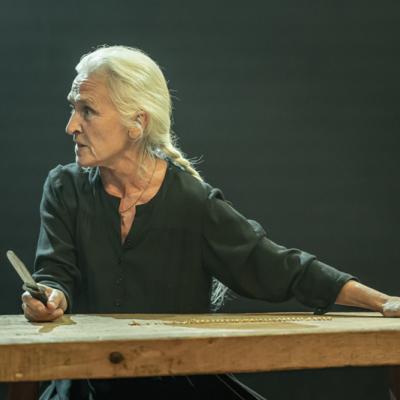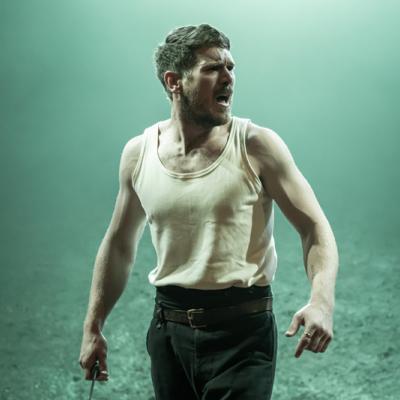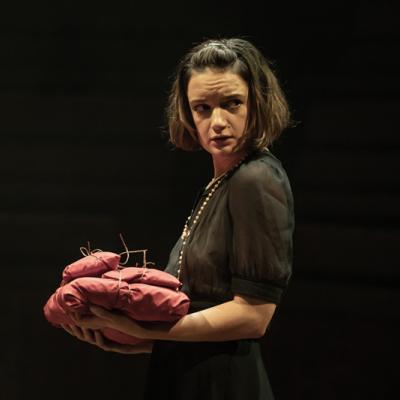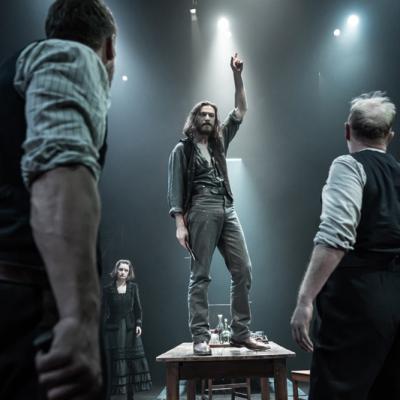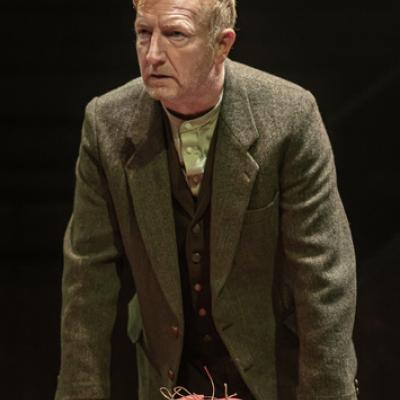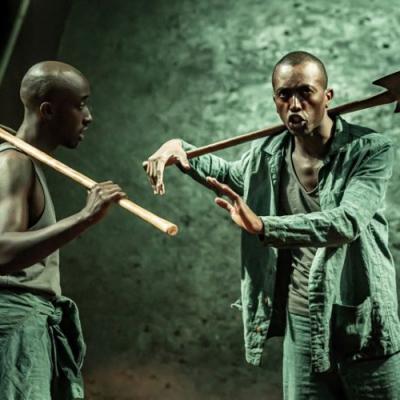Inside Blood Wedding takes you behind the scenes, giving you an insight into how this production came to life. From the original idea and the people behind the script, to the creatives and production teams who do amazing work to bring the show to our stage, Inside Blood Wedding explores how different elements come together to form what you experience at the Young Vic.
In conversation with the Creative Team
Kwame Kwei -Armah in conversation with Yaël Farber
ToggleKKA: I remember when we first spoke about working together at the Young Vic, I said, “why don’t we send each other a list of plays that we want to do”, and when we did, at the top of your list, and at the top of mine was Blood Wedding. We had both independently felt drawn to this work at this time. Why this story now?
YF: For me, making theatre is never about what I want to do, it’s always about what I feel seems urgent and necessary in the moment. I grew up in South Africa, which forged me in a very particular way; it taught me that when you have the platform, you should use it to say something that counts. I knew instinctively when the idea of Blood Wedding rose up between us, that this felt like the right moment to usher it into the world in a new way, because I think we’re in a very particular time in the world right now. I don’t think that there’s a linear trajectory to the history of human beings; I believe things move on a pendulum swing. We revisit and re-circle the same injuries, the same need for sacrifice, the same need to look into our hearts in a particular way. Right now, it feels like we’re building up again towards some kind of fever pitch, which is frightening, but it also breaks open the possibility for something transformative to happen. Which is pretty much what I believe about theatre; it should be frightening, and include our appetites for violence, because that’s what is true about us, but also include the extraordinary capacity we have for transformation. Blood Wedding is the liminal funeral feast capable of holding all these contradictions of the soul.
KKA: Speak to me a bit about Lorca – the way that you have excavated him, his mind, his art, his life, in order to craft a vision for this production?
YF: When I make any work my approach has always been to work out what the message in a bottle is that is trying to reach us from the writer at the time; what made the play urgent for Lorca? And why does it matter now? Because whatever it is that felt powerful to Lorca then, is the vital impulse that plugs us into the moment here.
Lorca wrote Blood Wedding in 1932, a few short years before the Spanish Civil War broke out and Spain was plunged into a genocide, which in many ways got lost in the shadow of the Second World War and the fascism that swept the world. As a gay man, and as an intellectual, Lorca was living in a society where these things were becoming fatally dangerous. He was someone who had a very deep commitment to his community, his society, yet who was also very connected to a larger artistic vision that was emerging across the world. He had a very close relationship with Salvador Dalí and was captivated by Surrealism. Surrealism, Futurism, Dadaism – all of these movements were responses to an anti-rationalism, because after the First World War it was impossible to put things together in the same way again; rationalism became some kind of absurd pretension, and so artists like Lorca were turning to surrealism for deeper truths. He was finally murdered by the rising regime and the sweep of fascism which would move across Spain, just a few years after Blood Wedding was born out of him. He is buried in an unmarked mass grave – his body has never been found. In the creation of this Blood Wedding, I have tried to keep close to the urgency of who Lorca was, what he suffered and how he was silenced.
Lorca said, “In Spain, the dead are more alive than the dead of any other country in the world.” In Blood Wedding there’s a reckoning with the inevitability of our end, our disappearance, the voices of our dead – a kind of sensuous, beautiful relationship with that inevitable appointment that we all have, but it also has no romance about what we’re capable of doing to each other. It’s a brutal play and I will not be shying away from the brutality, because that’s the truth of human nature, but equally it will not shy away from the incandescent capacities that the human soul has.
KKA: What do you hope people will leave this production thinking or feeling?
YF: I suppose every time I create theatre, I hope people leave the room in a deeper conversation with themselves. I think theatre is a ritual and a contemplative space. How we gather as a community to stare at the same pond and see our reflection is a very powerful thing to me, for us to gather around the fire like our ancestors did to tell stories and express our unlived lives, the things that perhaps we don’t dare to do. Theatre is wonderful that way because there are these extraordinary people called actors – individuals in society who say ‘I will live it for you.’
I suppose I want people to leave feeling like some kind of dial has been reset. Perhaps like they can see with a greater tenderness what’s unfolding in the world. It feels like a moment where anything is possible – transformation is possible, and plunging into the darkness is possible, and more so than usual because of a sweep across the world where people are polarising and tribalising.
This is why Blood Wedding is so interesting to me, because it’s about sectarianism and factionalism. It’s a metaphor; it’s a village, and how we learn inside a village to behave to avoid danger, and also how we learn to band together as a community to keep the wolves at bay, and within that, how we lose our personal freedoms, how we lose our capacity to live our lives. And this is where Lorca’s voice rises, because he fell in this very moment when such a thing was sweeping his country, and there’s something that he tried to send us then and it’s about trying to decipher the code in Lorca’s bottled message in order to better understand our own fragile, volatile times.
KKA: Yaël, I can’t thank you enough for coming here and bringing your art to our house.
YF: I can’t thank you enough for inviting me.DESIGN: Setting the scene with Yaël Farber and Marina Carr
ToggleYaël Farber and Marina Carr discuss the process of adapting and translating Lorca into a Blood Wedding setting which has the ability to speak to us here.
YF: Whenever I read any of Lorca’s poetry, it puts me more deeply in touch with who he was and what he was reachings towards, and his struggles and the vision he had. I always find that the translations of his poetry give something more vital. But when I’ve read the plays I could feel the strain of the transference from Spanish into English – what is innate metaphoric poetry and idiomatic becomes something different in an Anglo context. So the beautiful challenge to me is how you translate Lorca, and not lose what is connected to the earth, to our primal struggles and to the urgency and truth of what Lorca was trying to say. When thinking how to bring the spirit of the original Spanish text into an English spoken version, Marina Carr – having grown up in rural Ireland – understands how to iterate poetry in language in a way that has no sentimental attachment to being so. Marina is a lightning conductor for pulling the visceral charge of language right through words and back into the earth where that force belongs. Her gritty, immediate facility with language translates the spirit of what was available in the Irish language before being colonised, and that quality has somehow survived to this day inthe English spoken in Ireland. Writing into the deep song of Lorca through the Irish tongue of her own people, I knew Marina could harness the rural, visceral heart needed for the language of a Blood Wedding we both felt was possible beyond self-consciously poetic translations. And even though this reimagined village speaks in Marina’s Hibernian English – so too do we want to slip out of the rational reach of a neat transposition to an Irish Blood Wedding. This village that Lorca wrote up in the years preceding the Spanish genocide, exists beyond one place and time. They are us. We are them.
MC: In some ways Ireland is a logical choice when setting Lorca’s tragedy of the earth within an English-speaking backdrop. The repression of the individual by the long arms of Church and State is one obvious point of cohesion, but also both Spain and Ireland have endured the annihilation of identity and the psychic wound of colonisation; Spain by the reconquest of the land from the Moors, Ireland by many invasions culminating with the English.
Another meeting point of Rural Ireland and Rural Spain is Lorca’s admiration of the Irish writer John Millington Synge. As a young man in Granada he first discovered Synge’s Riders to the Sea, and a few years later when a student in Madrid he returned to Synge. One can’t help noticing the huge influence Synge had on the young Lorca, already a formidable poet and now a budding playwright
Blood Wedding asks the primal questions. The question of blood and blood lineage. Who was here first? What was taken? What is left? And what is the cost of that loss when examined through character in space and time?
YF: There are so many threads that tie these two countries together. The blood and beauty, the mud and guts of the language, and a world born of a weave between Paganism and Catholicism; a fraught political landscape; a deep engagement with language to express these multiple historical layers.
Ian Gibson, who wrote Lorca’s biography said ‘the Irish are just Spaniards who got lost.’ But even though we hear an Irish accent on stage, what I’m reaching for is that we do not identify exactly where we are. And it’s absolutely crucial that at the point where this piece breaks open into something that goes beyond rationalism, that we break open to the wider world.
MC: In Blood Wedding there is a quality that transcends place and time – as in all great writing. It is at heart a play about blood and blood letting and in that sense it is as ancient as ourselves. Melchor Fernandes Almagro, a close friend of Lorca’s, concentrating on the mythical aspect of Lorca’s Andalusia says, ‘Blood Wedding is not about Andalusians east or west, the mountains or the coast. It is about Andalusians in their deepest historical and psychological projection – Arabs, Romans, Greeks, the offspring of God knows what classical myths, the sun and the moon. And this is not a moon that has anything to do with the Romantics and Symbolism- but the real and mythical Moon of the Celtiberians, who offered up to her their hymns, bonfires, dances, songs.’ And one might add, last but not least, themselves.
‘Andalusia County Offaly’ is the landscape we arrived at, a melding of similarity in the people and their ancient and now vanished Modus Vivendi. We are true to the spirit and beauty of Lorca’s Andalusia, but a translation has to be set somewhere and Andalusia County Offaly seems to us the closest and the one that has the most traction. It allows fidelity to the great beating heart of Blood Wedding. It allows for all the idiosyncrasies of idiom and poetry of the Earth as spoken by the people. In other words it allows a fidelity of soul if not a literal fidelity.
In the rehearsal room
Research - The Spanish Civil War
ToggleJerwood Assistant Director, Emily Ling Williams, shares a selection of research from the creative process.
Federico García Lorca wrote Blood Wedding in 1932, one year after the founding of the Second Spanish Republic. The Republic had come to power with promises of greater rights for women, the disestablishment of the Catholic Church and land reform that would empower the working class. However, the new regime was met with strong opposition from Nationalist forces and in 1936, just four years into the Republic’s existence, the Spanish Civil War broke out. Lorca was one of the war’s first victims, as he was brutally executed at the hand of Nationalist forces in his home region of Andalucia. In Marina Carr’s new adaptation of Blood Wedding, she makes reference to Lorca’s violent death and to the hundreds of thousands who were killed in the years of war that followed. Therefore understanding the Spanish Civil War, its causes, its brutalities and its long-lasting impact, was vital for us as a company. Below are some of the references that we used to inform ourselves on this dark time in Spanish history.
Channel 4 Spanish Civil War Documentary: Episodes 1-6
Ten Minute History: The Spanish Civil War and Francisco Franco
Andalucia: Spanish Civil War Overview
Encyclopaedia Britannica: Spanish Civil War
In Our Time: Lorca
In Our Time: Spanish Civil War
Dolores Ibarriru: Left-wing leader in the Civil War and acquaintance of Lorca
Working Class Women in the 1931-1939 Spanish RepublicMovement - Assistant Director's diary extract
ToggleJerwood Assistant Director, Monique Touko, talks about Yael Farber's collaboration with Imogen Knight on movement
Yael and Imogen worked alongside each other to achieve a piece that was very much born from physical exploration. The actors were asked to engage their bodies to establish relationships, have a deeper understanding of a communal context and find their own specific characterisation.
The sessions began with Imogen leading the group in various physical exercises which grounded and connected them. The aim initially was to warm up the body and take the actor from being in their head to being in their bodies. The exercises tend to be repetitive and varied in intensity - this meant the actors could tailor their engagement according to their physical ability. The initial warm up would then evolve into detailed storytelling which used no dialogue and solely focused on how the bodies can communicate story.
The physical improvisations would allow the actors to find their physicality themselves and gain understanding of plot and their trajectory within that. Certain songs where used to underscore the work and aided to hold and maintain tension throughout. These sessions were very informative for both the actors and the creative team in fully visualising the possibilities and contributed very much to the final staging of Blood Wedding. In addition, the findings in the room due to the physical work were highly emotive and allowed us all to engage with the material at a visceral level which heightened the stakes and exposed the tragedy.
Federico García Lorca
Key dates in the life of Federico García Lorca
Toggle1898
Federico García Lorca is born on 5 June in Fuente Vaqueros, Spain, to a landowner father and a schoolteacher mother. His upbringing in rural Andalusia greatly influences his work.1916
He attends the University of Granada to study law, literature and composition. In 1916-17 Lorca travels throughout northern Spain with a professor of his university, who also encourages him to write his first book, Impresiones y Paisajes (Impressions and Landscapes) – printed at his father’s expense in 1918.1919
Lorca moves to the progressive, Oxbridge-inspired Residencia de Estudiantes in Madrid, while attending classes at the University of Madrid. He devotes the next decade to working on theatre, poetry and folk song.1920
He completes his first full-length play El Maleficio de la Mariposa (The Butterfly’s Evil Spell) which is performed in Madrid. The verse play tells the story of an impossible love between a cockroach and a butterfly.1921
Libro de Poemas, a collection of poetry based on folklore, is published. In Madrid Lorca becomes part of an influential group of artists and writers known as ‘Generación del 27’ which also includes artist Salvador Dalí and filmmaker Luis Buñuel. He discovers surrealism. Dalí becomes a friend, collaborator and possibly a lover, later designing the set for Lorca’s play Mariana Pineda.1927
Canciones (Songs) is published.1928
Romancero Gitano (Gypsy Ballads) is published. Inspired by the traditional Spanish ballad, this work was considered provocative and was re-printed seven times in his lifetime. It remains his best known book of poetry.1929
Lorca moves to New York, where he is deeply influenced by the vibrant culture of Harlem. He enrolls at Columbia University School of General Studies to study English. During this time he writes Poeta en Nueva York (Poet in New York), published posthumously in 1940.1930
Lorca returns to Spain. Funded by the Second Spanish Republic’s Ministry of Education, he leads a student theatre company around rural Spain, introducing audiences to classical Spanish theatre free of charge.1932
He writes Blood Wedding. He is inspired by a sensational crime he reads about in a newspaper in 1928, where it was reported that in the farming village of Níjar, a young man had been murdered after attempting to run away with a bride on the eve of her wedding. It was later revealed that the murderer had been the groom’s cousin.1933
Blood Wedding, the first part of his ‘Rural Trilogy’ is performed – Lorca’s first major success in theatre. It made him a good deal of money and firmly established his profile.1934
He writes Lament for the Death of a Bullfighter, his most famous long poem. Yerma, the second of the ‘Rural Trilogy’, is written and performed. Enraged by his left-wing sympathies and homosexulity, right-wing groups attempted to disrupt the first performance, but they are thrown out the theatre. The show is another huge success.1936
The House of Bernarda Alba, the last of the Trilogy, is also Lorca’s last play. It was published posthumously. The Spanish Civil War breaks out. In August Lorca is killed by a firing squad who were supporters of General Franco. His body has never been found.Lorca’s Classics and their relevance in the 21st Century
ToggleJerwood Assistant Directors, Emily Ling Williams and Monique Touko, explore Lorca's relevance today.
It was during a time of huge social and political upheaval that Federico García Lorca wrote the three plays now widely known as his rural trilogy: Blood Wedding, Yerma, and the House of Bernarda Alba. Spain was entering a new era with the loss of its empire, the fall of its monarchy and the founding of a new, democratic Republic. Conversations on class, gender and religion were pushed to the forefront of Spanish society and these debates, which are still so prevalent in the public consciousness today, resound in Lorca’s rural trilogy.
Unlike many works in the Western cannon, Lorca’s plays do not focus on society’s elites. Instead the characters he writes are peasants and labourers, who at that time were beginning to rise up across Spain and seize entire farms from their owners. In Blood Wedding he writes of a community stuck in an endless cycle of violence due to the fighting over land. In Yerma, Lorca creates a lead female character who frequently refers to the pagan elements of fire, land, wind and water, but yet who’s own name means ‘barren’. Lorca’s own rural upbringing and his resulting fascination with the land as something which is both the life force of humanity and is violently commodified by humanity makes his work hugely relevant to present debates on both class and the environment.
The psychological state of womanhood is also a running theme in Lorca’s rural trilogy. At the time that Lorca was writing, women had just been given the right to vote and the new Republic had introduced the most advanced marriage laws in Europe, recognising divorce by mutual consent and the right of women to custody of their children. This was met with huge backlash from the Catholic Church who saw their role in the life of rural families hugely reduced. This struggle between a woman’s desire for autonomy and the conventions that society imposes on her is beautifully interrogated in Lorca’s work. All the women in his plays are bound by their social functions. One way in which he shows this in Blood Wedding is by not giving the characters names so we only meet them as ‘Mother’, ‘Father’, “Bride’, ‘Groom’, making it all the clearer how the expected societal functions of each character oppress them as individuals.
Lorca writes multifaceted women who can be courageous and cruel, disadvantaged and enlightened, wild and restrained. Hardship is common to all the women in Lorca's work and bonds them to the brutal history of the country. It has often been suggested that Lorca's understanding of women in rural Spain and the psychological and philosophical impact of oppression was due to his own oppression as a homosexual. Same-sexual intercourse had been legalised by the Republic, but Lorca would later be executed by Nationalist forces at the start of the Spanish civil war. Lorca’s portrayal of women makes his works extremely relevant in the 21st Century as women still continue to cave out their own narratives in today’s patriarchal societies.
If you’d like to know more about Lorca’s work, below is a list of recent productions of his Rural Trilogy and links to the most recent student versions of the three texts.
YERMA
2019
Cervantes Theatre
Translated by Carmen Zapata and Michael Dewell
Adapted and Directed by Jorge de Juan
https://www.cervantestheatre.com/home/yerma/2016
Young Vic
by Simon Stone after Federico García Lorca
Direction Simon Stone
https://www.youngvic.org/whats-on/yerma2003
Royal Exchange
In a new translation by Pam Gems
Directed by Helena Kaut Howson
https://www.royalexchange.co.uk/171-yerma/fileBLOOD WEDDING
2019
Young Vic
In a new version by Marina Carr
Directed by Yaël Farber
https://www.youngvic.org/whats-on/blood-wedding2016
Cervantes Theatre
Translated by Carmen Zapata and Michael Dewell
Directed by Jorge de Juan
www.cervantestheatre.com/home/bloodwedding-cast-creative/2015
Graeae, Derby Theatre and Dundee Rep Ensemble
In a new version by David Ireland
Directed by Jenny Sealey
https://graeae.org/our-work/blood-wedding/THE HOUSE OF BERNARDA ALBA
2018
Fairfax Studio, Arts Centre Melbourne
New Version by Patricia Cornelius
Directed by Leticia Cáceres
https://www.artscentremelbourne.com.au/Event-Archive/2018/MTC/The-House…2017
Royal Exchange Manchester
New Version by Jo Clifford
Directed by Jenny Sealey
https://www.royalexchange.co.uk/whats-on-and-tickets/the-house-of-berna…2012
Almeida Theatre
A New Version by Emily Mann
Directed by Bijan Sheibani
https://almeida.co.uk/whats-on/the-house-of-bernarda-alba/19-jan-2012-1…YERMA: Methuen Drama Student Editions
Edited by Gwynne EdwardsBLOOD WEDDING: Methuen Drama Student Editions
Translated and Introduced by Jo CliffordHOUSE OF BERNARDA ALBA: Methuen Drama Student Editions
Edited by Gwynne Edwards
